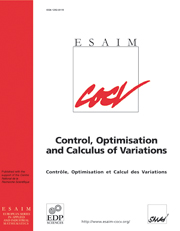Crossref Citations
This article has been cited by the following publications. This list is generated based on data provided by
Crossref.
Bonnard, B.
Cots, O.
Shcherbakova, N.
and
Sugny, D.
2010.
The energy minimization problem for two-level dissipative quantum systems.
Journal of Mathematical Physics,
Vol. 51,
Issue. 9,
Sugny, Dominique
2011.
Advances in Chemical Physics.
Vol. 147,
Issue. ,
p.
127.
Picot, Gautier
2012.
Shooting and numerical continuation methods for computing time-minimal and energy-minimal trajectories in the Earth-Moon system using low propulsion.
Discrete & Continuous Dynamical Systems - B,
Vol. 17,
Issue. 1,
p.
245.
Caillau, J.-B.
Cots, O.
and
Gergaud, J.
2012.
Differential continuation for regular optimal control problems.
Optimization Methods and Software,
Vol. 27,
Issue. 2,
p.
177.
Caillau, J.-B.
and
Daoud, B.
2012.
Minimum Time Control of the Restricted Three-Body Problem.
SIAM Journal on Control and Optimization,
Vol. 50,
Issue. 6,
p.
3178.
2013.
Applications of Contact Geometry and Topology in Physics.
p.
277.
Hintermüller, Michael
Marahrens, Daniel
Markowich, Peter A.
and
Sparber, Christof
2013.
Optimal Bilinear Control of Gross--Pitaevskii Equations.
SIAM Journal on Control and Optimization,
Vol. 51,
Issue. 3,
p.
2509.
Ndong, M
Salomon, J
and
Sugny, D
2014.
Newton algorithm for Hamiltonian characterization in quantum control.
Journal of Physics A: Mathematical and Theoretical,
Vol. 47,
Issue. 26,
p.
265302.
Chyba, Monique
Patterson, Geoff
Picot, Gautier
Granvik, Mikael
Jedicke, Robert
and
Vaubaillon, Jeremie
2014.
Designing rendezvous missions with mini-moons using geometric optimal control.
Journal of Industrial & Management Optimization,
Vol. 10,
Issue. 2,
p.
477.
Chyba, Monique
Granvik, Mikael
Jedicke, Robert
Patterson, Geoff
Picot, Gautier
and
Vaubaillon, Jeremie
2014.
Optimization and Control Techniques and Applications.
Vol. 86,
Issue. ,
p.
213.
Borum, Andy
and
Bretl, Timothy
2016.
Sufficient Conditions for a Path-Connected Set of Local Solutions to an Optimal Control Problem.
SIAM Journal on Applied Mathematics,
Vol. 76,
Issue. 3,
p.
976.
Chyba, Monique
Patterson, Geoff
and
Picot, Gautier
2016.
Recent Advances in Celestial and Space Mechanics.
Vol. 23,
Issue. ,
p.
179.
Sweilam, N. H.
Nagy, A. M.
and
Al-Ajami, T. M.
2021.
Numerical solutions of fractional optimal control with Caputo–Katugampola derivative.
Advances in Difference Equations,
Vol. 2021,
Issue. 1,




